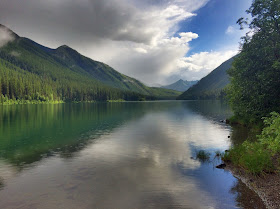Thunder rumbles in the distance. The intensity of the rain picks up. I splash along the shoreline- my shoes are soaked anyway and I can only feel half of my frozen toes, but a little more wet won’t matter. The lake water has risen to cover the gravely bank but I’m determined to get to the survey site before the storm rolls in. I'm out here doing surveys for Glacier National Park's Citizen Science Program, and there is still a view of the steep, snow-speckled Glacier Park peaks that I hope harbor mountain goats.
 |
| Is this storm coming in or heading out? |
Balancing my umbrella in my poncho, I pull out my binoculars and scan the cliffs. Binoculars fog up, get wiped clean, fog up again, then get rain-soaked. Goat-shaped rocks or rock-shaped goats? Is that goat-snow patch moving? Binocs are too blurry to tell.
 |
| Foggy binocs frustration. |
I retreat back to the ranger cabin porch to wait it out. What if the fog rolls in further? What if the rain keeps pouring all night? I don't know why it matters so much. I'm not getting paid. If I can't survey, it's OK. But still, I care. I want to see if the goats are out there. Curiosity, ah yes, you powerful modivator.
 |
| Waiting, watching, trying not to be cold. How could we be this cold in July? |
No sense in what- ifing. There is only listening to the rain drops through the forest. Watching the sparkle of light on wet forest. Marveling at the wonder of found-shelter. Soaking in the here-and-now. Breathing it in. There is only waiting and being present.
(Oh why is this stillness, this softness with the present moment so accessible out here, but sometimes hard to find inside buildings, inside cities?)
Slowly, very slowly, there is a brightness that appears in the distance. Is it moving this way?
Ah blue sky- what are you even? A little patch. But there nonetheless.
 |
| Blue skies. |
I move down again to the water’s edge where I can make out the distant peaks. Are you out there, mountain goats? Through the binoculars, there is a possible goat-rock or it is a real goat? Are those legs- oh it’s moving! It's a goat not a rock! Out come the spotting scope and tripod, and oh there are four goats sure enough.
 |
| One, two, three, F-O-U-R goats. |
Their locations is recorded in my citizen science data sheet. I watch them for a while longer. They move the way goats do, across impossible cliffs, nimble. Ah goats!
All it took was some waiting, some watching. Without the spotting scope, without that break in the weather, I'd never have seen them. How many things are like that? Without knowing how to look, without waiting for a clear view, you'd never even know that four goats were up there. I wonder how much more I'd see if I had this kind of patience in other situations.
 |
| Socked in with fog the next morning. But ah the stillness. |
Trip Info
The Boundary Trail led 7.2 miles above the Middle Fork of the Flathead from Headquarters to the Harrison Lake Trail. Then it was 4.8 miles to the Harrison Lake Campground, and 0.5 miles beyond to the goat site.
 |
| Along the Middle Fork of the Flathead. |
Only saw two other people in two days, and there was no one else at the campsite. No one. On a weekend in July. They say that Glacier National Park is crowded, but it’s not if you know where to go. Just don't tell anyone about Harrison Lake. Or tell them its a terribly overgrown trail.
 |
| Which is true. Here we are fighting through the bushes. The trail was only like this 75% of the time. |
The Belton Bridge was not the place for solitude, certainly. When returning to the trailhead, it was packed with people playing loud music and sunbathing in bikinis and whooping as they leapt into the water below. What a shocking onslought of humanity to return to after such a quiet and restorative two days. I strode by with my sun-umbrella, knee high gaiters, and long-sleeved
shirt, feeling feral and free, determined to carry the peace and wildness with me in my heart as I venture back into the week.
 |
| Harrison Lake- let's keep it quiet. |
Date Hiked: July 16-17, 2016
More about
Glacier National Park's Citizen Science Program.




































